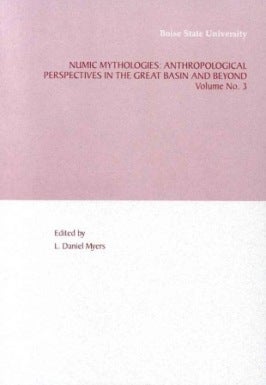 Occasional Papers and Monographs in Cultural Anthropology and Linguistics, Volume No. 3
Occasional Papers and Monographs in Cultural Anthropology and Linguistics, Volume No. 3
edited by L. Daniel Myers
ISBN: 0-9639749-8-X (2006)
163 PP.
Cost $22.00
Preface
For the Numic-speaking peoples of the Plains and Far West, oral literature (e.g., myths, legends, folktales, poetry, anecdotes, etc.) constitutes a body of verbal art that dominates their expressive culture. Until the 1980s, myths were regarded as mere descriptions and not appreciated for their value in communicating cultural traditions. Myths or myth summaries were collected and published to reveal the content of the story and little more. Interpretations were almost non-existent and what there was purely literal. Myths, like so many subjects considered esoteric, were incidental to ethnographic pursuits (Fowler 1986).
This volume drastically differs from the past in its problem-oriented ideational perspective. A number of papers presented in this volume contrast markedly with the descriptive nature of earlier research; they employ an interpretative approach to basic questions and issues of myth and its relationship to other parts of Numic culture. For the first time in the anthropological history of the Great Basin region, inquiry into Numic mythologies is based on a systematic study of a distinct subject matter. These essays provide a number of descriptive or interpretative perspectives on the nature and scope of mythological systems or processes within the Great Basin region. They counter the traditional behavioral approaches with their emphasis on the material culture of the Basin area by focusing on Numic expressive culture. While viewpoints vary greatly within this volume, all are concerned with cognition and cognitive processes related to expressive culture.
The anthropology of the Numic people is undergoing a revolutionary change by calling for transformation in the direction, conduct, and future of anthropological research in the 21st century. For both the Numic people and the community of anthropologists, the essays provided are excellent examples of the future of Numic anthropology.
This volume is dedicated to Demitri Boris Shimkin. Professor Shimkin had the insight to empower his successors to re-invigorate and revitalize the study of cultural anthropology in the Great Basin. His own research centered on cognition by focusing on expressive modes of culture or mechanisms of self-identity to gain access to a more inclusive context of Numic culture. Until his death in December 1992, Shimkin’s achievements in the study of the Numic culture (both Eastern and Western Shoshone) were surpassed only by his dedication to humanity. Through words and actions, the inspiration he provided served to motivate future generations of Great Basin anthropologists. With deep gratitude, this volume is dedicated to Professor Shimkin for the role he has played as an exemplary colleague, meticulous fieldworker, consummate scholar, supportive mentor, and, most of all, dear friend.
Table of Contents
- LIST OF FIGURES (ii)
- LIST OF TABLES (ii)
- PREFACE (iii)
- CHAPTER ONE. NUMIC MYTHOLOGIES, By L. Daniel Myers (1)
- CHAPTER TWO. WESTERN MONO MYTHOLOGY: ANUMIC ORAL TRADITION IN CALIFORNIA, By Christopher Loether (19)
- CHAPTER THREE. IDEOLOGY AND IDENTITY: WESTERN SHOSHONE “CANNIBAL” MYTH AS ETHNONATIONAL NARRATIVE, By Richard Clemmer (29)
- CHAPTER FOUR. MOUNTAIN SHEEP IN THE SKY: ORION’S BELT IN GREAT BASIN MYTHOLOGY, By Catherine S. Fowler (43)
- CHAPTER FIVE. ENCOUNTERS AT THE BOUNDARY OF WILDERNESS AND CIVILIZATION: SOUTHERN PAIUTE “TRUE STORIES” OF ANIMAL-HUMAN RELATIONS, By Robert Franklin (51)
- CHAPTER SIX. THE SHOSHONE GHOSE DANCE AND NUMIC MYTH: COMMON HERITAGE, COMMON THEMES, By Judith Vander (61)
- CHAPTER SEVEN. RECALLING THE PAST IN CREATING THE PRESENT: TOPOGRAPHY REFERENCES IN COMANCHE NARRATIVES, By Daniel J. Gelo (81)
- CHAPTER EIGHT. TOWARDS A NATURAL HISTORY OF THE NUMA. By L. Daniel Myers (95)
- CHAPTER NINE. ETIOLOGY AND IDEOLOGY IN THE GREAT BASIN, By David S. Whitley (103)
- ENDNOTES (117)
- REFERENCES CITED (127)